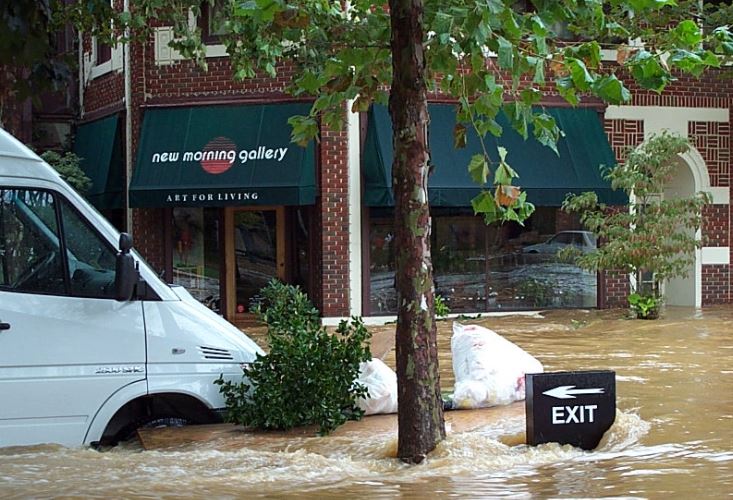Scene from Biltmore Village during the Flood of 2004. Asheville flooded when Hurricanes Ivan and Frances converged back-to-back on Western North Carolina that September, causing deaths and property damage.
Climate change is not just a buzzword or an agreement signed by nearly 200 nations recently gathered in Paris. It affects us here in Asheville. Climate change is expected to bring more flooding — and with it landslides — as well as drought — and with it fires, like the ones Western North Carolina experienced last fall.
In response to changing weather patterns, the City of Asheville’s Office of Sustainability is leading a cross-department team to identify weather-related risks and work toward preparedness.
“Per the National Centers for Environmental Information, 2016 yielded a total of $15 billion climate disaster events in the United States; four of which were due to flooding,” said Amber Weaver, the City’s Chief Sustainability Officer.
Residents here during the Floods of 2004 remember well the devastation wrought when two hurricanes converged on Western North Carolina that September. The impact: 11 deaths, 140 homes destroyed, another 16,234 damaged. The fallout: $200 million in total damages, including $87 million in lost tourism.
Now the City is working on a Climate Resiliency Plan. In partnership with an Asheville-based climate modeling organization called the National Environmental Modeling and Analysis Center (NEMAC) the plan’s first initial steps have been taken.
Climate resilience planning process
As with any battle, knowing your enemy is the first step to a tactical approach. In this case, the City and NEMAC identified Asheville’s climate stressors and accessed City assets vulnerable to extreme weather events, such as bridges that serve as major transportation arteries. The vulnerability analysis also looked at our steep slopes, prone to fail during unusually heavy rains.
Working with NEMAC, the City has completed the first phase of a climate resilience planning process. The next phase, happening this year, dovetails with the City’s Comprehensive Plan update to build in ways to prepare for and adapt to climate change.
“We cannot reverse the effects of climate change in the short term; however, the City is able to build in adaptive capacity measures to make the City’s assets more resilient,” said Weaver.
‘Adaptive capacity’
What does “adaptive capacity” look like? It is another term for planning for change. For example, increasing the diameter of culverts that channel stormwater away from roadways enhances the adaptive capacity of places that face flooding from increasingly heavy rainfalls.
“When we talk about building options to address climate stressors, it is important to consider structures that help make the City more resilient to climate impacts,” Weaver said.
The draft plan is still evolving, with more work to do, such as prioritize top actionable steps to protect our community. Look for more on this as the City’s Climate Resiliency Plan moves from draft to a more fleshed-out guiding document.
Council-led policy driving action
Asheville City Council, in the meantime, stands firm in its support of issues surrounding climate change and its impact. At its June 13 meeting, Council unanimously passed a resolution in support of the Paris climate agreement.
Mayor Esther Manheimer was one of 274 mayors who signed a letter of support saying they will adopt and uphold the commitments to the goals in the Paris Agreement.
Both actions align with Council’s Vision 2036, asserting the City’s commitment to a clean and healthy environment by supportive innovative technologies and conservation efforts in response to global climate change.
Related coverage
100 years after the Flood of 1916, the City of Asheville is ready for the next one
Simulation of the Flood of 2004 through Biltmore Village
